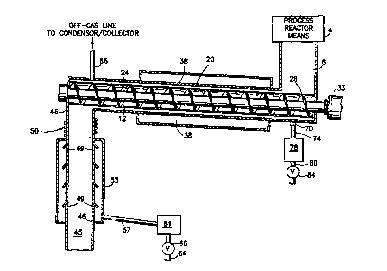Une partie des informations de ce site Web a été fournie par des sources externes. Le gouvernement du Canada n'assume aucune responsabilité concernant la précision, l'actualité ou la fiabilité des informations fournies par les sources externes. Les utilisateurs qui désirent employer cette information devraient consulter directement la source des informations. Le contenu fourni par les sources externes n'est pas assujetti aux exigences sur les langues officielles, la protection des renseignements personnels et l'accessibilité.
L'apparition de différences dans le texte et l'image des Revendications et de l'Abrégé dépend du moment auquel le document est publié. Les textes des Revendications et de l'Abrégé sont affichés :
| (12) Demande de brevet: | (11) CA 2175082 |
|---|---|
| (54) Titre français: | PROCEDE ET SYSTEME DE DECHARGE D'UN REACTEUR DE LIQUEFACTION DE PNEUMATIQUES |
| (54) Titre anglais: | TIRE LIQUEFYING PROCESS REACTOR DISCHARGE SYSTEM AND METHOD |
| Statut: | Réputée abandonnée et au-delà du délai pour le rétablissement - en attente de la réponse à l’avis de communication rejetée |
| (51) Classification internationale des brevets (CIB): |
|
|---|---|
| (72) Inventeurs : |
|
| (73) Titulaires : |
|
| (71) Demandeurs : |
|
| (74) Agent: | SMART & BIGGAR LP |
| (74) Co-agent: | |
| (45) Délivré: | |
| (86) Date de dépôt PCT: | 1994-10-27 |
| (87) Mise à la disponibilité du public: | 1995-05-04 |
| Requête d'examen: | 1996-08-09 |
| Licence disponible: | S.O. |
| Cédé au domaine public: | S.O. |
| (25) Langue des documents déposés: | Anglais |
| Traité de coopération en matière de brevets (PCT): | Oui |
|---|---|
| (86) Numéro de la demande PCT: | PCT/US1994/012303 |
| (87) Numéro de publication internationale PCT: | US1994012303 |
| (85) Entrée nationale: | 1996-04-25 |
| (30) Données de priorité de la demande: | ||||||
|---|---|---|---|---|---|---|
|
La présente invention concerne un système de décharge utilisé pour le processus de liquéfaction des pneumatiques dans un réacteur (4). Ce système comporte un collecteur (8) recevant les composants n'ayant pas subi de réaction, y compris du métal enduit d'huile, du réacteur (4). Ces composants sont entraînés à travers un réacteur pyrolytique (38) où ils sont amenés à une température permettant de liquéfier ou gazéifier par pyrolyse les composants hydrocarbure n'ayant pas subi de réaction. Le liquide et la plupart des gaz sont extraits du réacteur pyrolytique (38), le dispositif de décharge (45) raccordé au réacteur pyrolytique (38) transformant le gaz restant en condensat et déchargeant le métal. Ce condensat est également enlevé pour une utilisation ultérieure.
A discharge system is used with a tire liquefaction process using a reactor (4). The system includes a receiver (8) receiving unreacted
components, including oil coated metal, from the reactor (4). The unreacted components are moved through a pyrolysis reactor (38) where
they are heated to a temperature sufficient to convert the unreacted hydrocarbon components to a liquid and to gas by way of pyrolysis. The
liquid and the majority of gas are drawn off from the pyrolysis reactor (38). Discharge apparatus (45) connected to the pyrolysis reactor
(38) converts the remaining gas to a condensate and discharges the metal. The condensate is also removed for further use.
Note : Les revendications sont présentées dans la langue officielle dans laquelle elles ont été soumises.
Note : Les descriptions sont présentées dans la langue officielle dans laquelle elles ont été soumises.

2024-08-01 : Dans le cadre de la transition vers les Brevets de nouvelle génération (BNG), la base de données sur les brevets canadiens (BDBC) contient désormais un Historique d'événement plus détaillé, qui reproduit le Journal des événements de notre nouvelle solution interne.
Veuillez noter que les événements débutant par « Inactive : » se réfèrent à des événements qui ne sont plus utilisés dans notre nouvelle solution interne.
Pour une meilleure compréhension de l'état de la demande ou brevet qui figure sur cette page, la rubrique Mise en garde , et les descriptions de Brevet , Historique d'événement , Taxes périodiques et Historique des paiements devraient être consultées.
| Description | Date |
|---|---|
| Inactive : CIB de MCD | 2006-03-12 |
| Inactive : CIB de MCD | 2006-03-12 |
| Inactive : CIB de MCD | 2006-03-12 |
| Inactive : CIB de MCD | 2006-03-12 |
| Inactive : CIB de MCD | 2006-03-12 |
| Inactive : CIB de MCD | 2006-03-12 |
| Le délai pour l'annulation est expiré | 1998-10-27 |
| Demande non rétablie avant l'échéance | 1998-10-27 |
| Réputée abandonnée - omission de répondre à un avis sur les taxes pour le maintien en état | 1997-10-27 |
| Toutes les exigences pour l'examen - jugée conforme | 1996-08-09 |
| Exigences pour une requête d'examen - jugée conforme | 1996-08-09 |
| Demande publiée (accessible au public) | 1995-05-04 |
| Date d'abandonnement | Raison | Date de rétablissement |
|---|---|---|
| 1997-10-27 |
Les titulaires actuels et antérieures au dossier sont affichés en ordre alphabétique.
| Titulaires actuels au dossier |
|---|
| TEXACO DEVELOPMENT CORPORATION |
| Titulaires antérieures au dossier |
|---|
| CRAIG JOSEPH CASTAGNOLI |
| SUK-BAE CHA |
| VAHAN AVETISIAN |